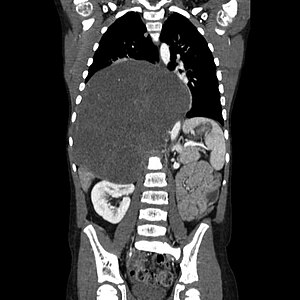Ganglioneuroma
| Ganglioneuroma | |
|---|---|
 |
|
| CT scan of a large ganglioneuroma within the chest cavity | |
| Classification and external resources | |
| Specialty | oncology |
| ICD-10 | D36.1 (ILDS D36.180) |
| ICD-O | M9490/0 |
| MedlinePlus | 001437 |
| MeSH | D005729 |
Ganglioneuroma is a rare and benign tumor of the autonomic nerve fibers arising from neural crest sympathogonia, which are completely undifferentiated cells of the sympathetic nervous system. However, ganglioneuromas themselves are fully differentiated neuronal tumors that do not contain immature elements.
Ganglioneuromas most frequently occur in the abdomen, however these tumors can grow anywhere sympathetic nervous tissue is found. Other common locations include the adrenal gland, paraspinal retroperitoneum, posterior mediastinum, head, and neck.
A ganglioneuroma is typically asymptomatic, and is typically only discovered when being examined or treated for another condition. Any symptoms will depend upon the tumor's location and the nearby organs affected.
For example, a tumor in the chest area may cause breathing difficulty, chest pain, and trachea compression. If the tumor is located lower in the abdomen, it may cause abdominal pain and bloating. A tumor near the spinal cord may cause spinal deformity or spinal compression, leading to pain and loss of muscle control or sensation in the legs and/or arms.
These tumors may produce certain hormones, which can cause diarrhea, an enlarged clitoris (in females), high blood pressure, increased body hair, and sweating.
Pathologically, ganglioneuromas are composed of ganglion cells, Schwann cells and fibrous tissue. Ganglioneuromas are solid, firm tumours that typically are white when seen with the naked eye.
...
Wikipedia
